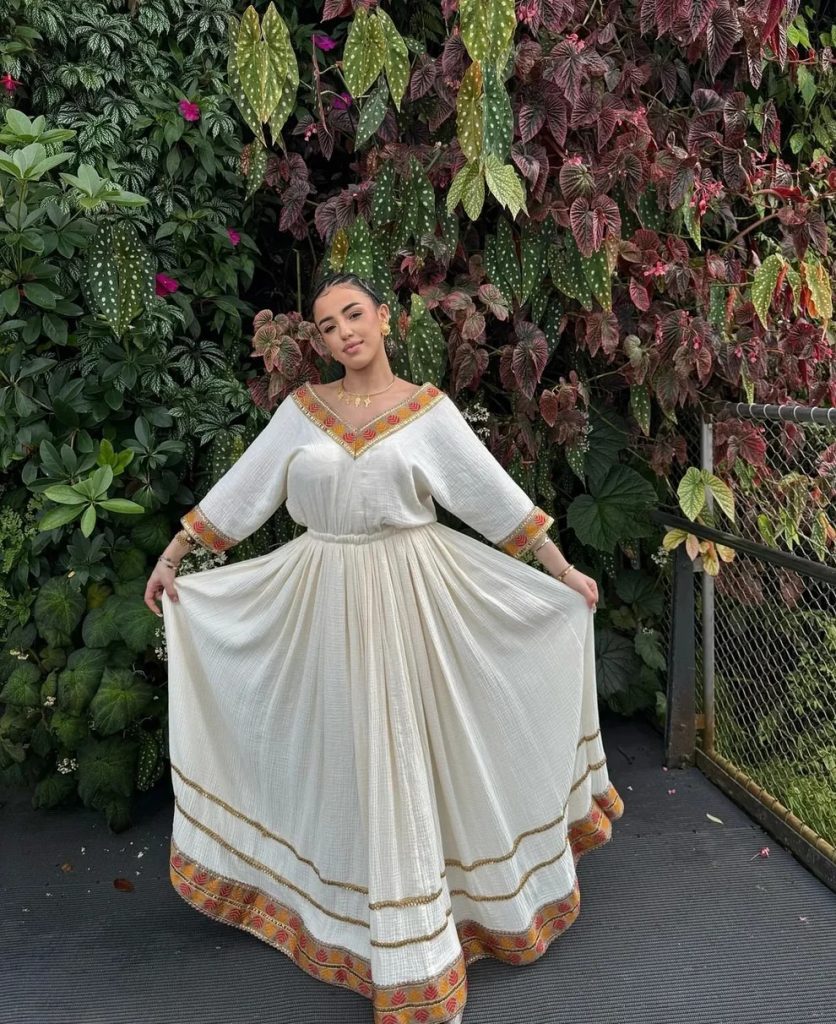Ethiopian Dresses for Weddings, Celebrations and Everyday Wear
Ethiopian fashion is known worldwide for its elegance, craftsmanship, and cultural depth. Among the most iconic styles is the Ethiopian traditional dress, a garment that carries history, artistry, and meaning in every stitch. Known locally as the Habesha dress or Habesha kemis, this attire is woven into the identity of Ethiopian and Eritrean communities and remains central to weddings, festivals, and even daily life.
While fashion trends constantly evolve, the Ethiopian dress has managed to hold its place both in cultural traditions and in modern style. Today, it is not only worn in Ethiopia and Eritrea but also across the diaspora, where it continues to serve as a bridge between heritage and modern identity.
This article explores the beauty and significance of Ethiopian dresses for weddings, celebrations, and everyday wear, while also comparing their Eritrean counterparts and examining how these garments are finding a place on global fashion stages.
What is an Ethiopian Traditional Dress?
The Ethiopian traditional dress is usually handwoven from soft cotton, known locally as shemma. These fabrics are often white or cream in colour, symbolising purity and celebration. What sets them apart is the tibeb (ጥበብ), intricate embroidery often stitched along the borders, sleeves, and neckline. This embroidery is more than decoration; it represents heritage, artistry, and, in many cases, regional identity.

Beautiful Habesha kemis worn for Ethiopian cultural celebration
These dresses come in different forms, but the most recognised is the Habesha dress. Women’s dresses are often floor-length with long sleeves, while men may wear a white cotton tunic with matching trousers and a shawl.
Regional variations exist. For example, in Gondar and Gojjam, colourful embroidery patterns dominate, while in Tigray, styles may be more minimal but carry distinctive designs. These small details tell stories of geography, craftsmanship, and family traditions.
Habesha Dress and Habesha Kemis: A Cultural Symbol
The Habesha dress is perhaps the most iconic form of Ethiopian clothing. For women, the Habesha kemis is the typical garment, long and flowing, often accompanied by a netela (a lightweight scarf) draped over the shoulders. These outfits are deeply symbolic, representing elegance, respect, and cultural pride.
The kemis is more than a fashion choice; it is a cultural identity marker. During celebrations or gatherings, a woman’s Habesha dress may signal marital status, family background, or even the type of event being attended. For men, a similar pride is carried through the shእmma, a traditional shawl worn with embroidered borders.
The craftsmanship is extraordinary. Traditionally, weaving is done by hand, often by skilled artisans using wooden looms. The UNESCO-recognised tradition of hand weaving in Ethiopia highlights how these garments are not just clothing but part of an intangible cultural heritage that connects generations.
Ethiopian Dresses for Weddings
Weddings in Ethiopia are grand celebrations, and attire plays a central role. The Ethiopian traditional dress worn by brides is often elaborate, featuring bright embroidery in gold, green, or red. Many brides choose multiple outfits, one for the church ceremony and another for the reception.
The bridal Habesha kemis often includes heavy tibeb embroidery around the neckline and hem, with designs passed down through families or selected for symbolic meaning. Brides sometimes pair their attire with a kaba, a velvet cape lined with embroidery that enhances the royal look.
Grooms wear a matching outfit, usually a white tunic and trousers, accessorised with a shawl or cloak that mirrors the bride’s embroidery. Together, the couple’s attire symbolises unity and heritage.
In modern Ethiopian weddings, many couples blend tradition with contemporary fashion. For example, a bride may wear a Western-style gown for part of the day but always incorporates the traditional Ethiopian dress into the celebration to honour family and heritage.
Ethiopian Dresses for Celebrations and Festivals
Ethiopian culture is full of vibrant celebrations, from religious festivals like Timket (Epiphany) to Meskel (Finding of the True Cross) and Enkutatash (New Year). During these occasions, people wear their finest Habesha dresses and Eritrean dresses, filling the streets and churches with colour and texture.
These dresses are not just formal wear; they carry spiritual and social meaning. White cotton symbolises purity, while embroidery colours may represent joy, fertility, or prosperity. During Timket, for example, worshippers often dress in white Habesha kemis, a sign of renewal and faith.
Community celebrations like weddings, christenings, or national holidays are also opportunities to showcase embroidery styles from different regions. It is common to see entire families dressed in coordinated Ethiopian traditional dresses, reinforcing unity and identity.
Everyday Wear of Ethiopian Traditional Dresses
While many people associate these garments only with formal events, the Ethiopian traditional dress also has an everyday side. In rural areas, women may wear simplified Habesha dresses for daily tasks, while men use practical cotton garments to cope with the climate.
In cities and diaspora communities, modern designers have reinterpreted the Habesha dress into everyday wear. Shorter versions of the kemis, casual tunics with tibeb embroidery, or contemporary cuts made with traditional fabrics are increasingly common. These adaptations allow younger generations to stay connected to heritage while embracing modern style.

White Ethiopian traditional dress with colourful woven edges
The Habesha kemis has also become a popular semi-formal choice for dinners, family events, or religious gatherings, where it strikes a balance between tradition and practicality.
Ethiopian Dress vs Eritrean Dress
The Ethiopian and Eritrean dress traditions share many similarities, as both cultures are rooted in the Habesha identity. Both use cotton fabric, white as the base colour, and tibeb embroidery as a defining feature.
However, Eritrean dresses often have bolder, more central embroidery that extends from the neckline down the middle of the dress. Ethiopian dresses, on the other hand, tend to feature embroidery along the borders and edges. Colours also vary; Eritrean styles often prefer bright reds and blues, while Ethiopian styles use a broader mix, including green and gold.
Despite these differences, both styles highlight the artistry of the Horn of Africa and are worn proudly at weddings, religious ceremonies, and community celebrations.
Modern Interpretations and Global Appeal
In recent years, the Ethiopian traditional dress has gained international recognition. Fashion designers are incorporating Habesha dresses into global runways, using traditional fabrics and embroidery to create contemporary looks.
Diaspora communities have played a major role in this growth. Ethiopian and Eritrean designers in the US, Europe, and the Middle East are reimagining these garments for international audiences, introducing shorter cuts, modern fabrics, and fusion styles.
Celebrities and influencers from Ethiopia and abroad have showcased Habesha kemis at cultural festivals and weddings, boosting their visibility worldwide. This global appeal demonstrates that Ethiopian fashion is not only about tradition but also about innovation.
How to Style and Care for Ethiopian Traditional Dresses
Styling a Habesha dress is both simple and versatile. Women often pair the kemis with gold or silver jewellery, traditional hairstyles like braid (ሹሩባ), and the netela scarf for modesty and elegance. Men may accessorise with a shemma (ሸማ) or wear their outfit with leather sandals.
Caring for these garments is essential because they are delicate. The cotton should be hand-washed or dry-cleaned to preserve the fabric and embroidery. Sun drying is preferred, but excessive heat can damage the fibres. Storing them properly, folded with a clean cloth around them, helps maintain their quality for years.
Where to Find Ethiopian Traditional Dresses
Finding authentic Ethiopian traditional dresses often means connecting with local artisans. Many villages still have hand weavers who pass down their craft through generations. In Addis Ababa and Asmእra, markets are filled with stalls selling authentic Habesha dresses and Eritrean dresses.
For those in the diaspora, Ethiopian boutiques and cultural shops in major cities like Washington DC, London, and Dubai stock traditional garments. Online platforms have also made it easier to buy authentic dresses directly from artisans in Ethiopia, though buyers should be careful to choose reputable sellers.
These purchases not only provide beautiful garments but also support the artisans who keep weaving traditions alive.

Eritrean dress with light brown embroidery and cotton fabric
The Ethiopian traditional dress is much more than fabric; it is a living symbol of culture, identity, and artistry. From the elegance of the Habesha kemis to the vibrant designs of the Eritrean dress, these garments are worn with pride during weddings, festivals, and daily life.
Modern designers are ensuring these traditions are not lost but reinterpreted for new generations. Whether at a wedding, a religious festival, or a family dinner, the Ethiopian dress continues to stand as a bridge between the past and the present.
For those who wear it, the dress carries not only style but also heritage, memory, and belonging. It is, without doubt, one of the most enduring cultural treasures of Ethiopia and Eritrea.
